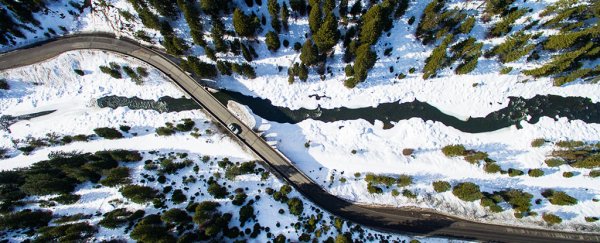They call Alaska the last frontier, but as the largest American state grapples with global warming happening twice as fast as anywhere else in the US, nobody knows for sure where its vast, changing landscape is headed.
Our best guess comes in the form of a new analysis sourced from over 30 years of satellite and climate data, which reveals a stunning 13 percent of Alaska underwent major environmental transformations between 1984 and 2015.
To give you a sense of how big an area we're talking about, the affected region amounts to approximately 174,000 square kilometres (67,000 square miles) of altered terrain – an area larger than the state of Wisconsin, or of Rhode Island and Florida combined.
To find this, a team of researchers led by the US Geological Survey mapped land and surface water changes across the whole of Alaska at an unprecedented level of surface resolution.
 Probability of change occurrence, and changing fire boundaries (USGS)
Probability of change occurrence, and changing fire boundaries (USGS)
For the purposes of the study, the "directional changes" detected – perceived in some 430,000 interpretations of 30 x 30 metre pixels sourced from Landsat observations – were defined as an "alteration to surface conditions due to disturbance, or ecological or geomorphological processes".
What that means is the changes can't directly be attributed to CO2-based climate change – as they could be evidence of other, naturally occurring phenomena – but the sheer scale of environmental upheaval revealed leaves little doubt human-caused global warming is a major culprit here.
Across the vast amounts of terrain catalogued, an equally vast amount of changes are taking place: glacial retreat, shrub and treeline expansion, wildfires, erosion, and pollution disturbances.
The weird thing is, in the midst of this rapidly shifting landscape, some of these simultaneous alterations almost seem to be contradicting one another.
While rising air temperatures are leading to extra vegetation growth and expansion, warming is also leading to increased evaporation in some areas, making it harder for plants to survive – let alone other life forms – and increasing the risk of fires.
 Coastal erosion spurred by melting permafrost (M. Torre Jorgenson)
Coastal erosion spurred by melting permafrost (M. Torre Jorgenson)
Meanwhile, other areas are getting wetter, with melting permafrost leading to surface water gains, as well as land subsidence and ground collapses.
Scientists are particularly concerned about these issues, as melting permafrost could unleash huge amounts of stored carbon, which many think will only compound the severity of the environmental changes we're seeing in Alaska – the most notable of which to date is wildfires.
"Significant browning trends were largely the result of recent wildfires in interior Alaska," the authors explain, "but browning trends are also driven by increases in evaporative demand and surface‐water gains that have predominately occurred over warming permafrost landscapes."
While nobody knows for sure where all this transforming terrain is headed, the potential for perhaps irrevocable future developments is a huge cause for concern, the team warns.
"The upshot is that combined effects could push systems past tipping points and impact large areas, especially after fires," says one of the researchers, USGS physical scientist Bruce Wylie.
While the outlook may be grim – and suggests Alaska is not responding in a "simple linear fashion" to the increased temperatures that come with global warming – other researchers say at least we've got this comprehensive dataset all in one place now, to help us comprehend whatever imperfect storm is headed Alaska's way.
"These are things that people have known about and reported on for some sections of Alaska, but I think the value of [the new] work is that they processed the information for the entire state," says global change biologist A. David McGuire from the University of Alaska Fairbanks, who wasn't involved in the study.
"It helps you understand the major types of change that are happening in Alaska."
The findings are reported in Global Change Biology.
